Failure Analysis Report: Hurricane Katrina Levees and Floodwalls
VerifiedAdded on 2020/03/13
|6
|1638
|49
Report
AI Summary
This report provides a comprehensive failure analysis of the Hurricane Katrina levee and floodwall system, detailing the catastrophic consequences of design and construction flaws. The analysis examines the primary causes of failure, including inadequate soil strength assessments, the presence of water-filled gaps, and negligent maintenance. It highlights how the United States Army Corps of Engineers' oversights, such as overestimating soil strength and failing to account for peat layers, contributed to the breaches. The report discusses the resulting loss of life, property damage, and economic impact, emphasizing the importance of accurate engineering practices, thorough risk assessment, and adherence to safety factors in civil engineering projects. The conclusion underscores the need for continuous improvement in design and construction to prevent future disasters, using past failures as a foundation for enhancing the safety of both people and property. The report uses the case study to emphasize the importance of considering complex technical issues and the need for engineers to learn from past mistakes.
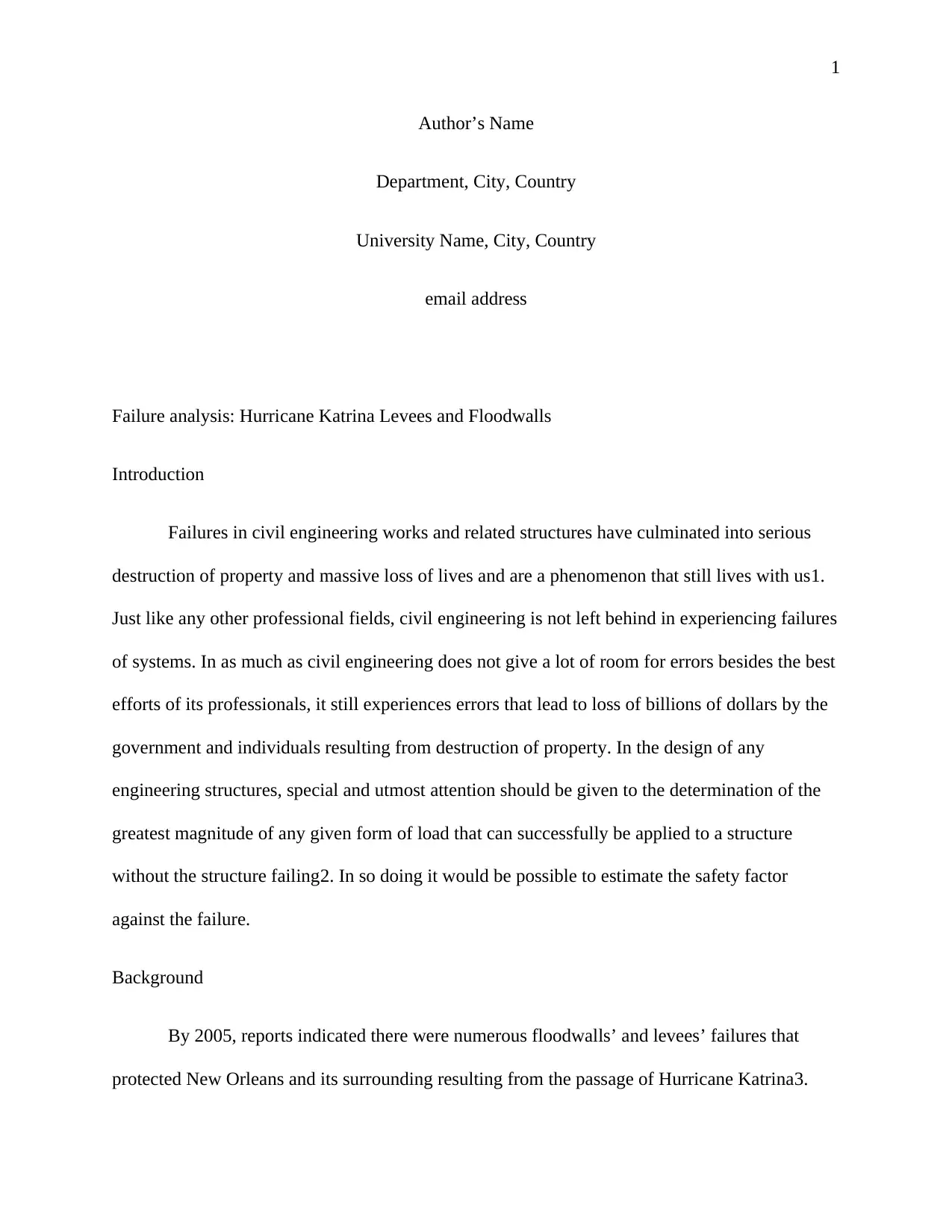
1
Author’s Name
Department, City, Country
University Name, City, Country
email address
Failure analysis: Hurricane Katrina Levees and Floodwalls
Introduction
Failures in civil engineering works and related structures have culminated into serious
destruction of property and massive loss of lives and are a phenomenon that still lives with us1.
Just like any other professional fields, civil engineering is not left behind in experiencing failures
of systems. In as much as civil engineering does not give a lot of room for errors besides the best
efforts of its professionals, it still experiences errors that lead to loss of billions of dollars by the
government and individuals resulting from destruction of property. In the design of any
engineering structures, special and utmost attention should be given to the determination of the
greatest magnitude of any given form of load that can successfully be applied to a structure
without the structure failing2. In so doing it would be possible to estimate the safety factor
against the failure.
Background
By 2005, reports indicated there were numerous floodwalls’ and levees’ failures that
protected New Orleans and its surrounding resulting from the passage of Hurricane Katrina3.
Author’s Name
Department, City, Country
University Name, City, Country
email address
Failure analysis: Hurricane Katrina Levees and Floodwalls
Introduction
Failures in civil engineering works and related structures have culminated into serious
destruction of property and massive loss of lives and are a phenomenon that still lives with us1.
Just like any other professional fields, civil engineering is not left behind in experiencing failures
of systems. In as much as civil engineering does not give a lot of room for errors besides the best
efforts of its professionals, it still experiences errors that lead to loss of billions of dollars by the
government and individuals resulting from destruction of property. In the design of any
engineering structures, special and utmost attention should be given to the determination of the
greatest magnitude of any given form of load that can successfully be applied to a structure
without the structure failing2. In so doing it would be possible to estimate the safety factor
against the failure.
Background
By 2005, reports indicated there were numerous floodwalls’ and levees’ failures that
protected New Orleans and its surrounding resulting from the passage of Hurricane Katrina3.
Paraphrase This Document
Need a fresh take? Get an instant paraphrase of this document with our AI Paraphraser
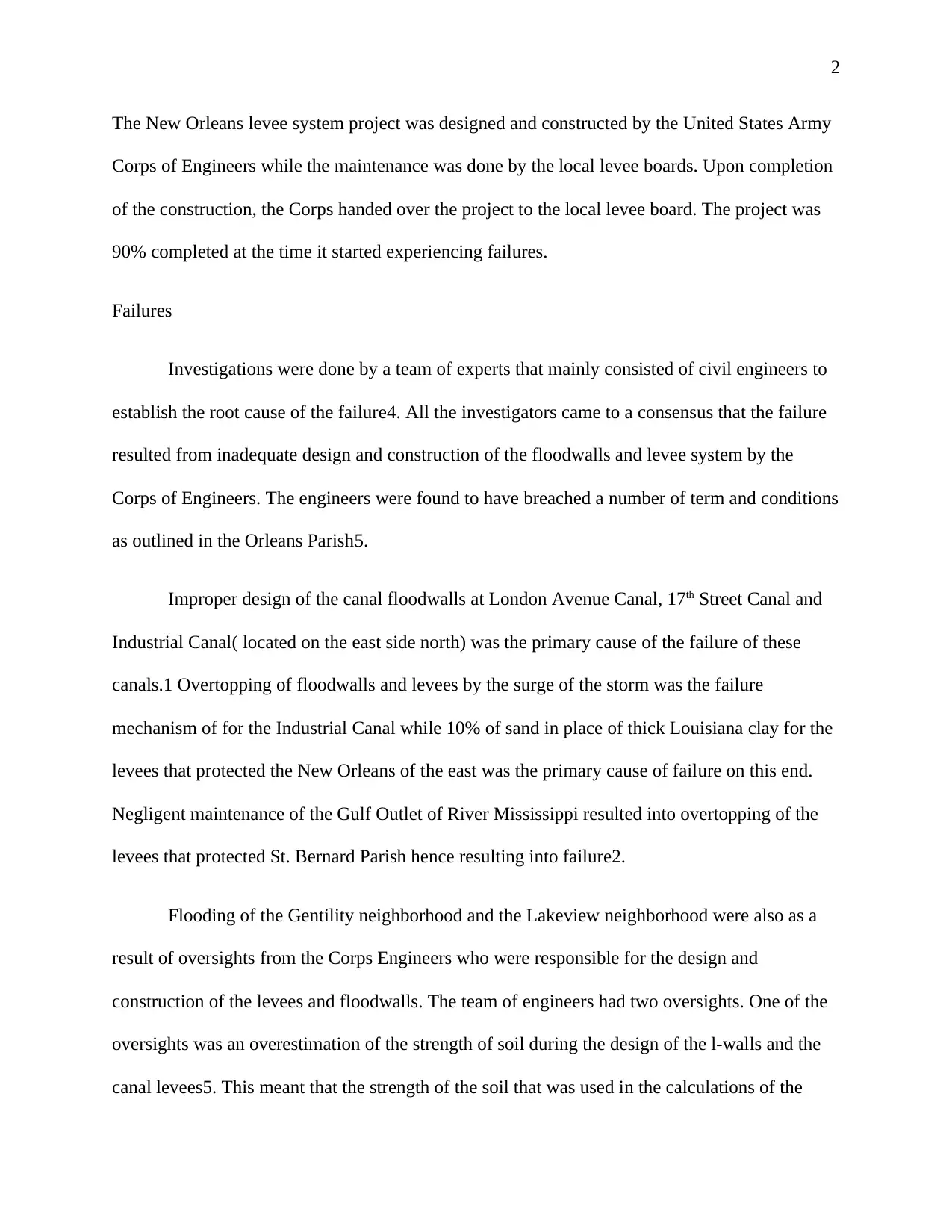
2
The New Orleans levee system project was designed and constructed by the United States Army
Corps of Engineers while the maintenance was done by the local levee boards. Upon completion
of the construction, the Corps handed over the project to the local levee board. The project was
90% completed at the time it started experiencing failures.
Failures
Investigations were done by a team of experts that mainly consisted of civil engineers to
establish the root cause of the failure4. All the investigators came to a consensus that the failure
resulted from inadequate design and construction of the floodwalls and levee system by the
Corps of Engineers. The engineers were found to have breached a number of term and conditions
as outlined in the Orleans Parish5.
Improper design of the canal floodwalls at London Avenue Canal, 17th Street Canal and
Industrial Canal( located on the east side north) was the primary cause of the failure of these
canals.1 Overtopping of floodwalls and levees by the surge of the storm was the failure
mechanism of for the Industrial Canal while 10% of sand in place of thick Louisiana clay for the
levees that protected the New Orleans of the east was the primary cause of failure on this end.
Negligent maintenance of the Gulf Outlet of River Mississippi resulted into overtopping of the
levees that protected St. Bernard Parish hence resulting into failure2.
Flooding of the Gentility neighborhood and the Lakeview neighborhood were also as a
result of oversights from the Corps Engineers who were responsible for the design and
construction of the levees and floodwalls. The team of engineers had two oversights. One of the
oversights was an overestimation of the strength of soil during the design of the l-walls and the
canal levees5. This meant that the strength of the soil that was used in the calculations of the
The New Orleans levee system project was designed and constructed by the United States Army
Corps of Engineers while the maintenance was done by the local levee boards. Upon completion
of the construction, the Corps handed over the project to the local levee board. The project was
90% completed at the time it started experiencing failures.
Failures
Investigations were done by a team of experts that mainly consisted of civil engineers to
establish the root cause of the failure4. All the investigators came to a consensus that the failure
resulted from inadequate design and construction of the floodwalls and levee system by the
Corps of Engineers. The engineers were found to have breached a number of term and conditions
as outlined in the Orleans Parish5.
Improper design of the canal floodwalls at London Avenue Canal, 17th Street Canal and
Industrial Canal( located on the east side north) was the primary cause of the failure of these
canals.1 Overtopping of floodwalls and levees by the surge of the storm was the failure
mechanism of for the Industrial Canal while 10% of sand in place of thick Louisiana clay for the
levees that protected the New Orleans of the east was the primary cause of failure on this end.
Negligent maintenance of the Gulf Outlet of River Mississippi resulted into overtopping of the
levees that protected St. Bernard Parish hence resulting into failure2.
Flooding of the Gentility neighborhood and the Lakeview neighborhood were also as a
result of oversights from the Corps Engineers who were responsible for the design and
construction of the levees and floodwalls. The team of engineers had two oversights. One of the
oversights was an overestimation of the strength of soil during the design of the l-walls and the
canal levees5. This meant that the strength of the soil that was used in the calculations of the
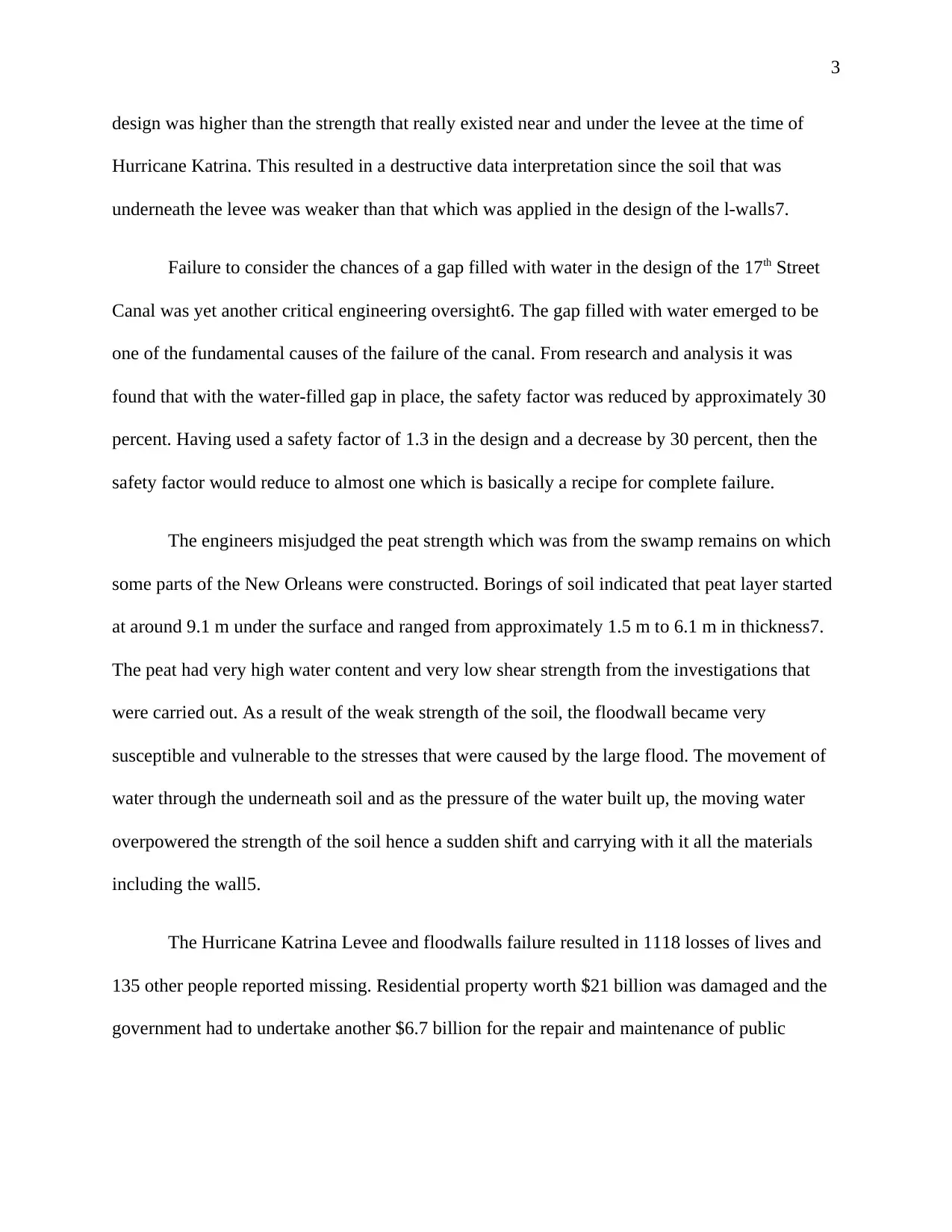
3
design was higher than the strength that really existed near and under the levee at the time of
Hurricane Katrina. This resulted in a destructive data interpretation since the soil that was
underneath the levee was weaker than that which was applied in the design of the l-walls7.
Failure to consider the chances of a gap filled with water in the design of the 17th Street
Canal was yet another critical engineering oversight6. The gap filled with water emerged to be
one of the fundamental causes of the failure of the canal. From research and analysis it was
found that with the water-filled gap in place, the safety factor was reduced by approximately 30
percent. Having used a safety factor of 1.3 in the design and a decrease by 30 percent, then the
safety factor would reduce to almost one which is basically a recipe for complete failure.
The engineers misjudged the peat strength which was from the swamp remains on which
some parts of the New Orleans were constructed. Borings of soil indicated that peat layer started
at around 9.1 m under the surface and ranged from approximately 1.5 m to 6.1 m in thickness7.
The peat had very high water content and very low shear strength from the investigations that
were carried out. As a result of the weak strength of the soil, the floodwall became very
susceptible and vulnerable to the stresses that were caused by the large flood. The movement of
water through the underneath soil and as the pressure of the water built up, the moving water
overpowered the strength of the soil hence a sudden shift and carrying with it all the materials
including the wall5.
The Hurricane Katrina Levee and floodwalls failure resulted in 1118 losses of lives and
135 other people reported missing. Residential property worth $21 billion was damaged and the
government had to undertake another $6.7 billion for the repair and maintenance of public
design was higher than the strength that really existed near and under the levee at the time of
Hurricane Katrina. This resulted in a destructive data interpretation since the soil that was
underneath the levee was weaker than that which was applied in the design of the l-walls7.
Failure to consider the chances of a gap filled with water in the design of the 17th Street
Canal was yet another critical engineering oversight6. The gap filled with water emerged to be
one of the fundamental causes of the failure of the canal. From research and analysis it was
found that with the water-filled gap in place, the safety factor was reduced by approximately 30
percent. Having used a safety factor of 1.3 in the design and a decrease by 30 percent, then the
safety factor would reduce to almost one which is basically a recipe for complete failure.
The engineers misjudged the peat strength which was from the swamp remains on which
some parts of the New Orleans were constructed. Borings of soil indicated that peat layer started
at around 9.1 m under the surface and ranged from approximately 1.5 m to 6.1 m in thickness7.
The peat had very high water content and very low shear strength from the investigations that
were carried out. As a result of the weak strength of the soil, the floodwall became very
susceptible and vulnerable to the stresses that were caused by the large flood. The movement of
water through the underneath soil and as the pressure of the water built up, the moving water
overpowered the strength of the soil hence a sudden shift and carrying with it all the materials
including the wall5.
The Hurricane Katrina Levee and floodwalls failure resulted in 1118 losses of lives and
135 other people reported missing. Residential property worth $21 billion was damaged and the
government had to undertake another $6.7 billion for the repair and maintenance of public
⊘ This is a preview!⊘
Do you want full access?
Subscribe today to unlock all pages.

Trusted by 1+ million students worldwide
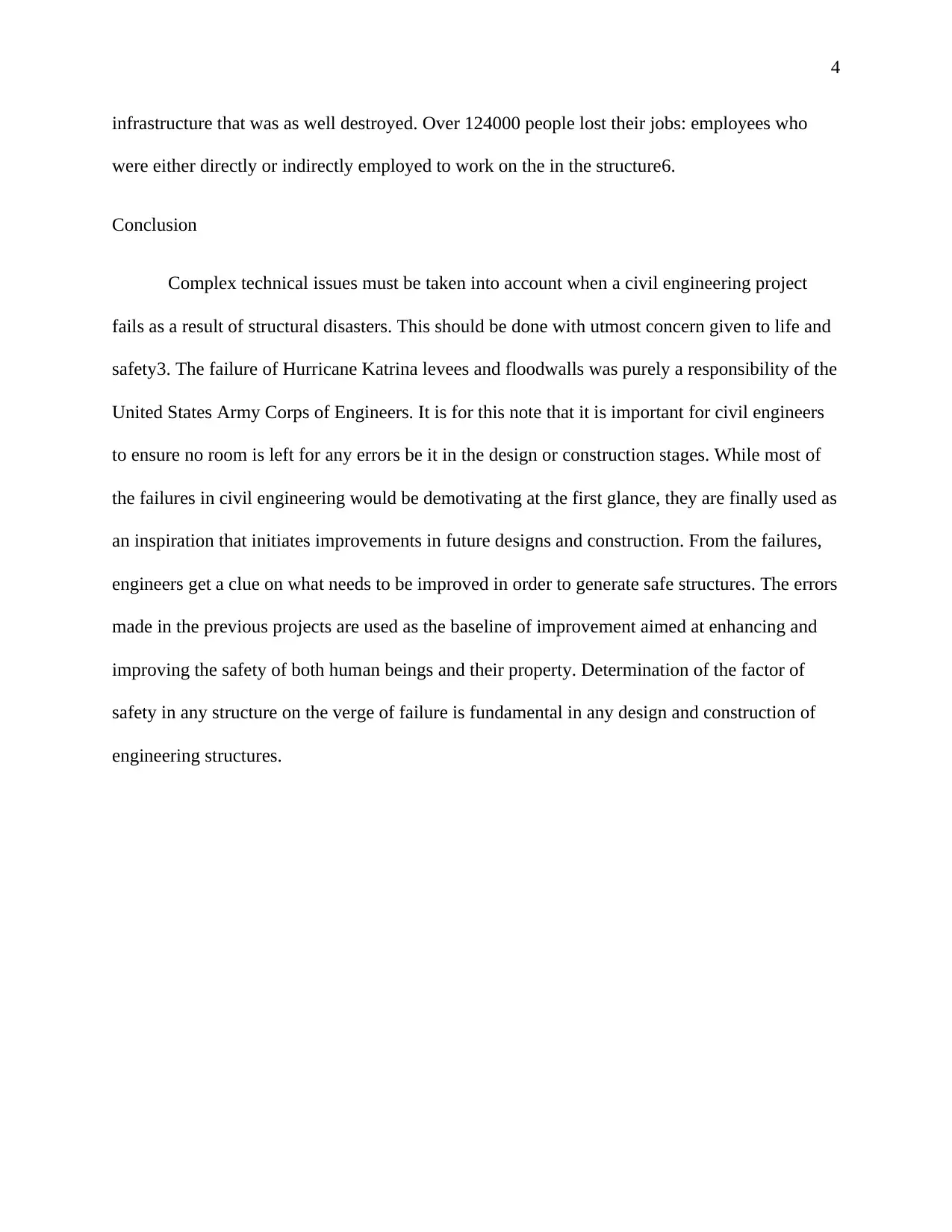
4
infrastructure that was as well destroyed. Over 124000 people lost their jobs: employees who
were either directly or indirectly employed to work on the in the structure6.
Conclusion
Complex technical issues must be taken into account when a civil engineering project
fails as a result of structural disasters. This should be done with utmost concern given to life and
safety3. The failure of Hurricane Katrina levees and floodwalls was purely a responsibility of the
United States Army Corps of Engineers. It is for this note that it is important for civil engineers
to ensure no room is left for any errors be it in the design or construction stages. While most of
the failures in civil engineering would be demotivating at the first glance, they are finally used as
an inspiration that initiates improvements in future designs and construction. From the failures,
engineers get a clue on what needs to be improved in order to generate safe structures. The errors
made in the previous projects are used as the baseline of improvement aimed at enhancing and
improving the safety of both human beings and their property. Determination of the factor of
safety in any structure on the verge of failure is fundamental in any design and construction of
engineering structures.
infrastructure that was as well destroyed. Over 124000 people lost their jobs: employees who
were either directly or indirectly employed to work on the in the structure6.
Conclusion
Complex technical issues must be taken into account when a civil engineering project
fails as a result of structural disasters. This should be done with utmost concern given to life and
safety3. The failure of Hurricane Katrina levees and floodwalls was purely a responsibility of the
United States Army Corps of Engineers. It is for this note that it is important for civil engineers
to ensure no room is left for any errors be it in the design or construction stages. While most of
the failures in civil engineering would be demotivating at the first glance, they are finally used as
an inspiration that initiates improvements in future designs and construction. From the failures,
engineers get a clue on what needs to be improved in order to generate safe structures. The errors
made in the previous projects are used as the baseline of improvement aimed at enhancing and
improving the safety of both human beings and their property. Determination of the factor of
safety in any structure on the verge of failure is fundamental in any design and construction of
engineering structures.
Paraphrase This Document
Need a fresh take? Get an instant paraphrase of this document with our AI Paraphraser
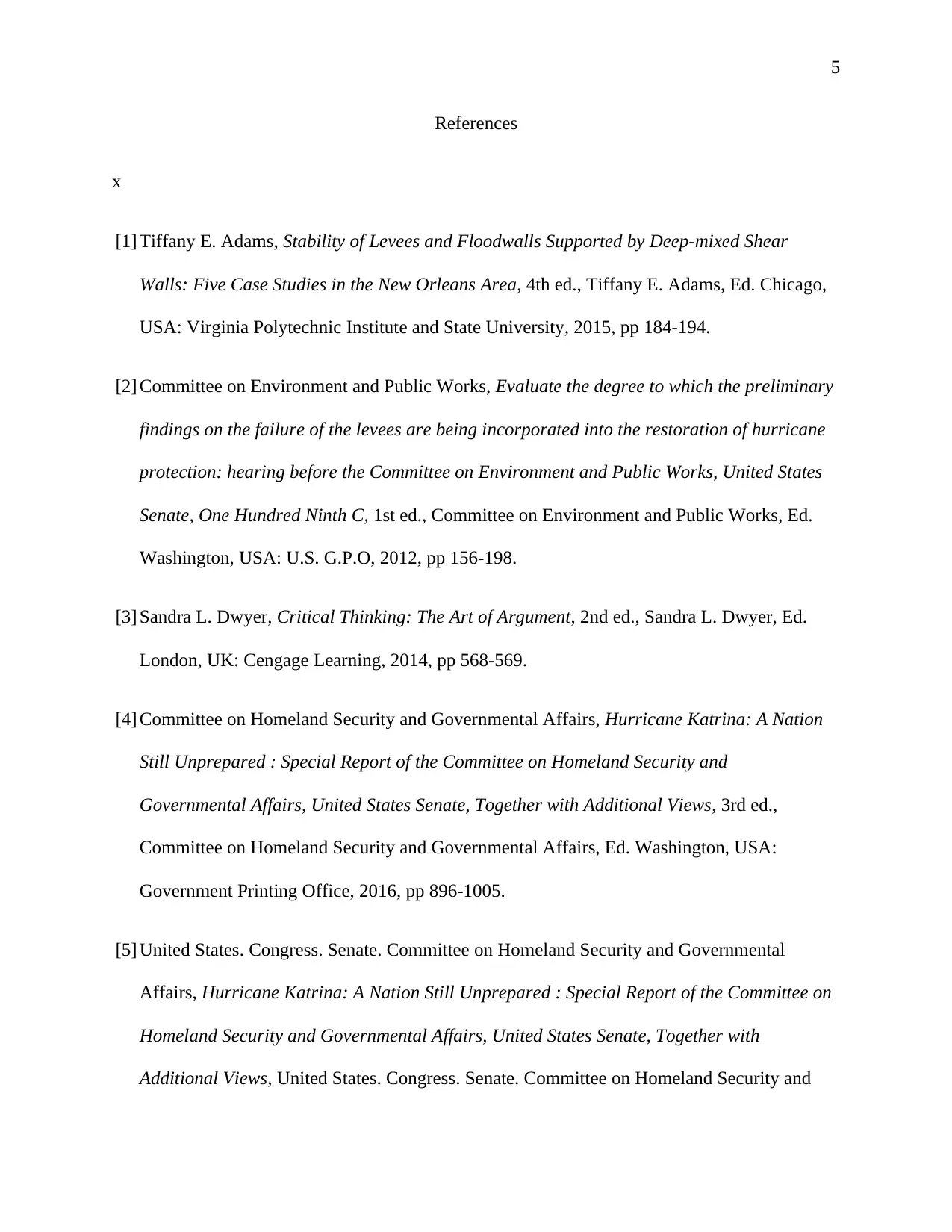
5
References
x
[1] Tiffany E. Adams, Stability of Levees and Floodwalls Supported by Deep-mixed Shear
Walls: Five Case Studies in the New Orleans Area, 4th ed., Tiffany E. Adams, Ed. Chicago,
USA: Virginia Polytechnic Institute and State University, 2015, pp 184-194.
[2] Committee on Environment and Public Works, Evaluate the degree to which the preliminary
findings on the failure of the levees are being incorporated into the restoration of hurricane
protection: hearing before the Committee on Environment and Public Works, United States
Senate, One Hundred Ninth C, 1st ed., Committee on Environment and Public Works, Ed.
Washington, USA: U.S. G.P.O, 2012, pp 156-198.
[3] Sandra L. Dwyer, Critical Thinking: The Art of Argument, 2nd ed., Sandra L. Dwyer, Ed.
London, UK: Cengage Learning, 2014, pp 568-569.
[4] Committee on Homeland Security and Governmental Affairs, Hurricane Katrina: A Nation
Still Unprepared : Special Report of the Committee on Homeland Security and
Governmental Affairs, United States Senate, Together with Additional Views, 3rd ed.,
Committee on Homeland Security and Governmental Affairs, Ed. Washington, USA:
Government Printing Office, 2016, pp 896-1005.
[5] United States. Congress. Senate. Committee on Homeland Security and Governmental
Affairs, Hurricane Katrina: A Nation Still Unprepared : Special Report of the Committee on
Homeland Security and Governmental Affairs, United States Senate, Together with
Additional Views, United States. Congress. Senate. Committee on Homeland Security and
References
x
[1] Tiffany E. Adams, Stability of Levees and Floodwalls Supported by Deep-mixed Shear
Walls: Five Case Studies in the New Orleans Area, 4th ed., Tiffany E. Adams, Ed. Chicago,
USA: Virginia Polytechnic Institute and State University, 2015, pp 184-194.
[2] Committee on Environment and Public Works, Evaluate the degree to which the preliminary
findings on the failure of the levees are being incorporated into the restoration of hurricane
protection: hearing before the Committee on Environment and Public Works, United States
Senate, One Hundred Ninth C, 1st ed., Committee on Environment and Public Works, Ed.
Washington, USA: U.S. G.P.O, 2012, pp 156-198.
[3] Sandra L. Dwyer, Critical Thinking: The Art of Argument, 2nd ed., Sandra L. Dwyer, Ed.
London, UK: Cengage Learning, 2014, pp 568-569.
[4] Committee on Homeland Security and Governmental Affairs, Hurricane Katrina: A Nation
Still Unprepared : Special Report of the Committee on Homeland Security and
Governmental Affairs, United States Senate, Together with Additional Views, 3rd ed.,
Committee on Homeland Security and Governmental Affairs, Ed. Washington, USA:
Government Printing Office, 2016, pp 896-1005.
[5] United States. Congress. Senate. Committee on Homeland Security and Governmental
Affairs, Hurricane Katrina: A Nation Still Unprepared : Special Report of the Committee on
Homeland Security and Governmental Affairs, United States Senate, Together with
Additional Views, United States. Congress. Senate. Committee on Homeland Security and
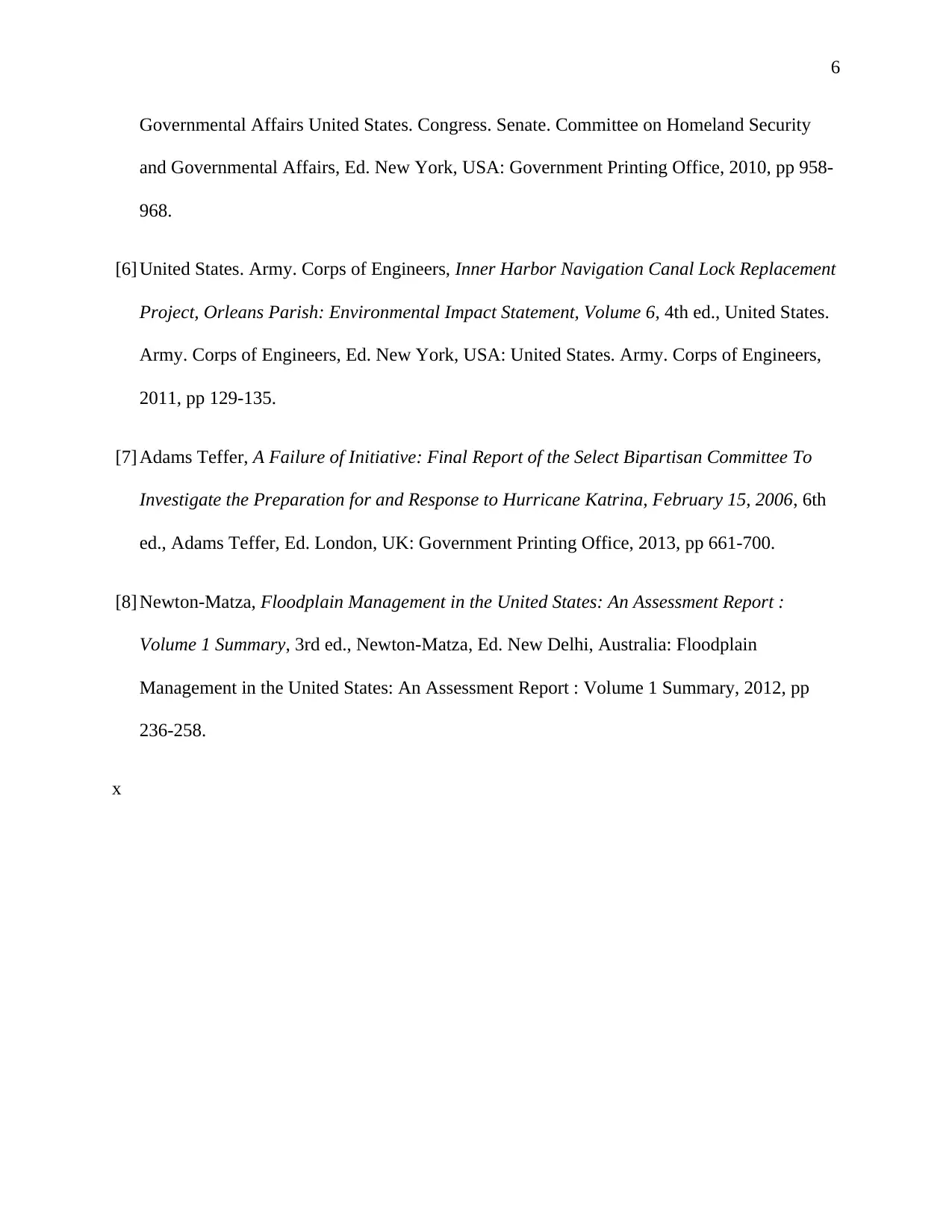
6
Governmental Affairs United States. Congress. Senate. Committee on Homeland Security
and Governmental Affairs, Ed. New York, USA: Government Printing Office, 2010, pp 958-
968.
[6] United States. Army. Corps of Engineers, Inner Harbor Navigation Canal Lock Replacement
Project, Orleans Parish: Environmental Impact Statement, Volume 6, 4th ed., United States.
Army. Corps of Engineers, Ed. New York, USA: United States. Army. Corps of Engineers,
2011, pp 129-135.
[7] Adams Teffer, A Failure of Initiative: Final Report of the Select Bipartisan Committee To
Investigate the Preparation for and Response to Hurricane Katrina, February 15, 2006, 6th
ed., Adams Teffer, Ed. London, UK: Government Printing Office, 2013, pp 661-700.
[8] Newton-Matza, Floodplain Management in the United States: An Assessment Report :
Volume 1 Summary, 3rd ed., Newton-Matza, Ed. New Delhi, Australia: Floodplain
Management in the United States: An Assessment Report : Volume 1 Summary, 2012, pp
236-258.
x
Governmental Affairs United States. Congress. Senate. Committee on Homeland Security
and Governmental Affairs, Ed. New York, USA: Government Printing Office, 2010, pp 958-
968.
[6] United States. Army. Corps of Engineers, Inner Harbor Navigation Canal Lock Replacement
Project, Orleans Parish: Environmental Impact Statement, Volume 6, 4th ed., United States.
Army. Corps of Engineers, Ed. New York, USA: United States. Army. Corps of Engineers,
2011, pp 129-135.
[7] Adams Teffer, A Failure of Initiative: Final Report of the Select Bipartisan Committee To
Investigate the Preparation for and Response to Hurricane Katrina, February 15, 2006, 6th
ed., Adams Teffer, Ed. London, UK: Government Printing Office, 2013, pp 661-700.
[8] Newton-Matza, Floodplain Management in the United States: An Assessment Report :
Volume 1 Summary, 3rd ed., Newton-Matza, Ed. New Delhi, Australia: Floodplain
Management in the United States: An Assessment Report : Volume 1 Summary, 2012, pp
236-258.
x
⊘ This is a preview!⊘
Do you want full access?
Subscribe today to unlock all pages.

Trusted by 1+ million students worldwide
1 out of 6
Related Documents
Your All-in-One AI-Powered Toolkit for Academic Success.
+13062052269
info@desklib.com
Available 24*7 on WhatsApp / Email
![[object Object]](/_next/static/media/star-bottom.7253800d.svg)
Unlock your academic potential
Copyright © 2020–2025 A2Z Services. All Rights Reserved. Developed and managed by ZUCOL.




